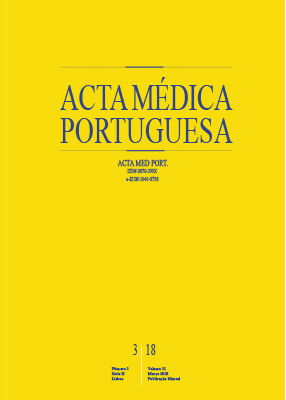Prevalência de Obesidade Abdominal e Excesso Ponderal em Crianças Portuguesas e a Importância de Incluir a Obesidade Abdominal nas Consultas Médicas
DOI:
https://doi.org/10.20344/amp.9000Palavras-chave:
Adiposidade, Criança, Índice de Massa Corporal, Obesidade Abdominal, Obesidade Pediátrica, PortugalResumo
Introdução: A obesidade abdominal em crianças tem aumentado a ritmo alarmante, mas esse indicador não é avaliado em consultas médicas de rotina. Este estudo pretende avaliar a prevalência de excesso ponderal e obesidade abdominal e a relação entre os dois indicadores de obesidade, em crianças dos 6 aos 10 anos.
Material e Métodos: Numa amostra de 793 crianças (408 raparigas) foram medidos o peso, altura e a circunferência abdominal. Os critérios da International Obesity Task Force foram usados para definir o excesso ponderal e obesidade. Obesidade abdominal foi estimada como a relação cintura/altura ≥ 0,50. Testes estatísticos foram usados para testar os objetivos supramencionados.
Resultados: A prevalência de excesso ponderal, incluindo obesidade foi de 21,9% (18,9 – 25,0), sendo significativamente mais elevada nas raparigas do que nos rapazes (χ2 = 4,59, p = 0,03). A prevalência de obesidade abdominal foi de 21,9% (18,6 – 25,0), sem diferenças significativas em relação ao género (χ2 = 3,32, p = 0,07). Verificámos que 8,2% (5,9 – 10,6) das crianças com peso normal e 59,5% (50,9 – 69,0) de crianças com excesso ponderal tinham obesidade abdominal.
Discussão: A prevalência de obesidade, incluindo abdominal, é elevada nas crianças portuguesas, mas parece ter estabilizado nos últimos anos. Várias crianças com obesidade abdominal foram consideradas não obesas segundo os indicadores da International Obesity Task Force.
Conclusão: Dado que várias crianças não obesas apresentam valores elevados de obesidade abdominal, a medição da relação cintura/altura deve ser incluída em consultas médicas de rotina, de modo a permitir uma melhor avaliação do estado de saúde da criança.
Downloads
Downloads
Publicado
Como Citar
Edição
Secção
Licença
Todos os artigos publicados na AMP são de acesso aberto e cumprem os requisitos das agências de financiamento ou instituições académicas. Relativamente à utilização por terceiros a AMP rege-se pelos termos da licença Creative Commons ‘Atribuição – Uso Não-Comercial – (CC-BY-NC)’.
É da responsabilidade do autor obter permissão para reproduzir figuras, tabelas, etc., de outras publicações. Após a aceitação de um artigo, os autores serão convidados a preencher uma “Declaração de Responsabilidade Autoral e Partilha de Direitos de Autor “(http://www.actamedicaportuguesa.com/info/AMP-NormasPublicacao.pdf) e a “Declaração de Potenciais Conflitos de Interesse” (http://www.icmje.org/conflicts-of-interest) do ICMJE. Será enviado um e-mail ao autor correspondente, confirmando a receção do manuscrito.
Após a publicação, os autores ficam autorizados a disponibilizar os seus artigos em repositórios das suas instituições de origem, desde que mencionem sempre onde foram publicados e de acordo com a licença Creative Commons









